What Happens When the Data is Right
Prodx was built on a simple idea: if you get the product data right, everything else becomes easier to build.
Schedule My Demo
Get Started
Get started for Prodx Products.

Product Documentation
How each products works?

Product Overview
Overview of all products by Prodx.

Book a Demo Call
Book a demo call with us today.
Built on Prodx
Built on Prodx
Substitutes API
Search API
Recommendations API
Variations API
Filters API
Categories API
Aisles App
Sponsored Product Platform
Personalization
Overview
Prodx was built on a simple idea: if you get the product data right, everything else becomes easier to build.
Every API, personalization engine, and retail media platform we’ve created sits on the same standardized product data foundation—deeply structured, universally categorized, and enriched with over 100,000+ attributes.
On this page, you’ll find the tools we built to prove what’s possible. From substitutes and search, to merchandising and retail media, each capability was designed to showcase what you can do when the data does the heavy lifting.
Schedule My Demo
Personalization
Personalization at Prodx doesn’t live in a silo. It’s not a separate feature or an optional add-on—it’s embedded in the very structure of how we handle data. Because every product is deeply attributed and every customer interaction is tied to those attributes, personalization becomes a natural extension of the data, not a separate layer on top of it.
Powered by:
Our personalization engine is driven entirely by:
- Standardized product attributes, including over 1,200+ QualityTypes and 100,000+ individual Qualities
- Order history tied to attribute preferences, not SKUs
- Attribute-level preference scoring, understanding which product features a customer tends to choose—whether or not they realize it
- No demographic profiles or personas, just clean, product-level behavioral signals
- Direct integration with Prodx-powered APIs and merchandising slots, so personalization flows through every surface
Because we understand why a customer chooses something—not just what they chose—we can build a profile around real behavior, not assumptions.
What it enables:
- Attribute-level personalization for every shopper
- Tailored results in Substitutes, Search, Recommendations, and more
- Recognizes patterns like “always buys organic,” “prefers specific scent families,” or “avoids dairy”
- Personalized merchandising across product lists, using attribute-driven slot targeting
- Individual, not persona-based logic
- Each shopper is unique. Our system builds their profile based solely on their actions—not someone else’s average
Why it’s different: Most personalization systems rely on broad strokes: personas, demographics, or shared traits across a segment. They make assumptions, group people together, and optimize for averages.
Prodx personalization is different:
- It’s rooted in individual order history
- It uses standardized product attributes, not inferred preferences or external data
- It builds a real-time profile of what actually matters to each customer—brand, flavor, size, packaging type, dietary tags, and more
- It’s silent, adaptive, and precise—shoppers never have to “set preferences” because the system learns from every interaction
- It’s woven into every surface of the experience: from product carousels to search results to merchandising plans
- It scales automatically across categories, brands, and new products—because it’s built into the foundation, not hard-coded on top
The result is clarity and control.
For the shopper: a smoother, more relevant experience.
For the retailer: stronger conversion, deeper loyalty, and fewer bad results.
Sponsored Product Platform
Built on the Prodx data foundation, our Sponsored Product Platform was one of the first to fully integrate product data, shopper signals, and retail media logic into a single, scalable ad system. While the platform will sunset later this year, it remains a proof point of what's possible when data is built right—and used right.
Powered By: The Prodx Sponsored Product Platform was made possible by our deeply structured data foundation and direct integration with Experience APIs. Key capabilities included:
- Standardized product categories and attributes
- Enabled targeting not just by product, but by relevant attributes like Brand, Flavor, Size, and more
- Allowed campaigns to focus on shopper preferences, not just SKUs
- Attribute-level shopper understanding
- By tying purchases to product attributes, we could identify which features truly mattered to each customer
- Made it possible to personalize ads around shopper intent, not just behavior
- Cross-surface ad placement across 6 key locations
- Ads were slotted natively into:
- Search
- Past Purchases
- Category Groups
- Category Product Lists
- Substitutes
- Recommendations
- Created broad reach without disrupting the shopping flow
- Ads were slotted natively into:
- Slot-level merchandising logic
- Gave precise control over where ads appeared—within specific slots, based on relevance, margin, brand, or campaign logic
- Clean relevance layer for in-context delivery
- Ads were filtered by relevance to the query, category, or shopper profile
What it enabled:
- Cost Per Conversion Model: Brands only paid when their product was purchased—not clicked
- More Ad Slots Without Cannibalization: Because ads were highly relevant and personalized, more placements could be safely monetized without hurting the customer experience
- Advanced Shopper Segmentation: Prodx introduced Market Loyalty Types:
- Defend: loyal customers to your brand
- Acquire: new customers in the category
- Steal: shoppers loyal to your competitor
- Recapture: lapsed customers who tried your product but switched
- Bid Modifiers Based on Loyalty Type: Brands could prioritize spend where it mattered most—like winning back lost customers or defending their base
- Opportunity Analytics: We measured every time a SKU appeared on a digital shelf—like Search, Past Purchases, or Recommendations—where another product was ultimately purchased. These were tracked as Opportunities:
“Missed moments where a targeted campaign could have improved visibility and potentially won the sale.”
- Real-Time Attribution: Brands could see exactly which experiences and placements led to conversion
- Category-Aware Targeting: Because Prodx mapped every product to 10,000+ categories, ad logic aligned with shopper behavior and true product relationships
Why it’s different: Most retail media platforms were adapted from traditional ad tech—retrofitted to product pages and driven by impressions or clicks.
The Prodx platform was different because it was built on the data itself. That meant:
- Ads were native to the experience: Not bolted on, but layered into Search, Recommendations, and Category pages via product relevance
- Campaigns were logic-driven: Target by attribute, category, or shopper behavior—no guesswork
- Performance was purchase-based: Brands paid for sales, not scrolls
- Opportunities were visible and measurable: Brands could see where they missed conversions due to lack of presence—not lack of relevance
- Every bid could be strategic: Thanks to Market Loyalty Types and Bid Modifiers, you could actually shape your audience strategy inside the platform
And at the heart of it was a vision.
As our founder often said, there was an imbalance in eCommerce: Retailers carried the cost, while brands reaped the sales.
We built this platform to correct that imbalance. Our goal was to help retailers monetize every single slot—without sacrificing the shopper experience. Because we controlled the relevance layer, we could guarantee that even a sponsored placement felt like a natural fit.
The result?
More revenue for the retailer. More precision for the brand. And a better experience for the shopper.
In real numbers:
- 100+ brands activated campaigns
- The platform delivered $6+ average ROAS over a three year time span
- Retailer grew ad revenue by 4x, unlocking entirely new streams of incremental profit

Even as we sunset the platform, the takeaway is clear:
This is what happens when retail media is powered by great data.
Aisles App
The Aisles App is our dynamic merchandising platform, built directly on top of Prodx’s standardized data. It allows retailers to create, deploy, and test custom merchandising plans across any product surface—from search results to recommendation carousels. Every slot becomes a lever for growth, personalization, and precision.
Powered by: Prodx merchandising is built on top of our standardized product data foundation and integrates deeply with:
- Structured product attributes (1,200+ QualityTypes and 100,000+ standardized Qualities)
- Slot-level logic, informed by standardized data and shopper context
- Personalization and loyalty signals, tied to shopper preferences
- Category-aware taxonomy, ensuring merchandising logic behaves consistently across the entire catalog
- Analytics & optimization hooks, enabling performance comparison by aisle, slot, and plan
It all runs through our proprietary Aisles App, which lets merchandising teams build, deploy, and optimize plans at scale.
What it enables:
- Full slot-level merchandising control on any product listing page—search results, PLPs, cart, carousels, recommendations, etc.
- Real-time plan deployment: configure merchandising plans and go live in seconds
- Contextual targeting: activate plans for specific queries, categories, or campaigns (e.g., “Thanksgiving turkey” or “Lunchbox snacks”)
- Built-in personalization: every plan becomes dynamic when tied to shopper data, so product slotting adjusts in real time
- Detailed performance analytics: if connected to our analytics platform, view reporting by aisle, slot type, and merchandising plan
Slotting Options Include:
For every slot, you can control both relevance logic and slot type strategy.
Relevance Tier:
- Any Tier – show results from any relevance group
- Top Tier Only – only show highly relevant products
- Top Tier First – mix results, but lead with relevance
Slot Type Options:
- Any Result: Next product from the default product list.
- Past Purchase: Product from the customers order history.
- High Margin: Price -Cost. Product with the highest difference.
- Private Label: Retailer branded product.
- New Product: Products that have been added to catalog within the last 6 months.
- On Sale: Product that has a Sale Price < Regular Price.
- Preferences Match: Product matches x% of a customer's purchased attributes.
- Top Seller: Product in the top 25% based on sales rank.
- Specific Product: Place a specific SKU using your Internal Id.
- Specific Attribute: Place a specific Quality (e.g. Vegan) or Category (e.g. Sliced Cheese)
- External Ad: Place an ad from a third party vendor.
Why it’s different: Most merchandising systems are rigid, slow to execute, and disconnected from both the product data and the shopper context.
Prodx merchandising is different because it’s:
- Slot-based – You control individual product positions with precision
- Plan-based – Create one or many merchandising plans, A/B test them, and deploy instantly
- Contextual – Assign plans to specific queries or category pages
- Dynamic – Results are personalized, each list of products adapts per customer
- Measurable – With analytics integrated, you can view performance down to the slot level
Because it’s all built on our standardized data model, merchandising becomes:
- Faster to execute
- More strategic
- Easier to personalize and scale
You’re not just placing products. You’re programming personalized digital aisles—and you’re doing it in real time.
Categories API
The Categories API returns a structured, navigable hierarchy of product categories—standardized and ready to drive seamless digital browsing. Whether powering a traditional "Shop by Aisle" interface or a dynamic, personalized category journey, this API provides the backbone.
It’s built on Prodx’s granular categorization system, but also supports custom structures to reflect retailer-specific taxonomy or merchandising goals. The API returns both Groups (broad category clusters) and Products (individual categories), enabling dynamic UI construction and merchandising opportunities.
Powered By
- 10,000+ Prodx-standardized Categories
- Fully navigable hierarchy from Browse → Category
- Support for custom paths, groupings, and filtered outputs
- Integration with merchandising logic via Aisles App
What It Enables
- “Shop by Aisle” navigation across mobile, app, and web
- Flexible support for retailer- specific taxonomy needs
- Dynamic construction of:
- Department menus
- Category landing pages
- Breadcrumbs and navigation layers
- Category-specific merchandising opportunities
- Personalized paths for browsing based on shopper preferences or past behavior
Why It’s Different
- Rooted in standardized, deeply structured data (not just flat category lists)
- Categories are built for substitution logic, merchandising, and personalization
- Enables hybrid models: use our hierarchy, or merge it with your own
- Returns category metadata to fuel deeper insights and better filtering
- Enables dynamic merchandising and personalization at the category level
Filters API
The Filters API enables dynamic, context-aware filtering experiences on digital shelves—powered directly by Prodx’s structured product data. Instead of relying on static attribute lists or hard-coded filters, the API returns relevant filters based on the actual set of products being viewed.
Powered By:
- 10,000+ granular product Categories
- 1,200+ QualityTypes defining filterable attribute types
- Product-level Quality tagging
- Eligibility flag: FiInclude = True on any Quality or QualityType that should be exposed as a filter
What It Enables
- Dynamically generated filter menus based on the products in view
- Attribute-level filtering for things like:
- Flavor
- Brand
- Diets & Lifestyles: Organic / Vegan / Gluten-Free
- Pack Size
- Consistent shopper experience across Search and Category browsing
- Elimination of irrelevant filters that clutter UI or break user trust
Why It’s Different
- Filter options are generated from standardized data, not manually curated per category
- Supports real-time API delivery for fluid shopper UX
- Automatically scales with your catalog — when a new product enters a category, it inherits the correct filters
- Enables more intelligent personalization: shoppers can filter based on their preferences, not generic groupings
Variations API
Returns structured variations of a given product—automatically grouped and sorted using Prodx’s standardized data. Variants can be organized across one or many QualityTypes, including flavor, scent, pack size, sub-brand, or form (e.g., powder vs. liquid).
Because the logic is built at the category level, it scales automatically across the entire catalog—offering the industry’s first fully dynamic variations experience. Variations can also extend across related categories using our “Structures” system, enabling broader product comparison (e.g., liquid vs. powder detergents).
- Powered by: Category level QualityTypes, standardized attribute values (e.g., flavor, size, pack count)
- What it enables: Seamless grouping of product variations (e.g., flavors, sizes, brands) into a single display unit
A recent test with a major retailer showed that shoppers who interacted with Variations added 1–2 more items to their cart on average.
At another retailer, results were even stronger:
- Variant adoption more than doubled (4.93% → 10%)
- PDP add-to-cart conversion for users engaging with variants increased from 34% → 50%
- Average order value from variant-driven purchases rose ~12%
- Interactions with variants grew +180%
- Cart additions grew +204%
- Orders from PDP cart additions grew +208%
- Overall period-over-period revenue increased +16%
- Why it’s different: Most variations systems rely on manual rules or SKU-level connections—linking a few products that seem related. At Prodx, we built our Variations API from the data layer up, asking: What actually defines a variation?
By analyzing each Category in our taxonomy, we identified the QualityTypes that matter most—like Brand, Flavor, Scent, or Size—and used those to define how variation sets should be constructed within each Category. Once defined, that logic applies automatically to every product in the Category, past or future. No manual mapping needed.
This structure means:
- Variation logic is defined once, at the Category level
- It scales automatically to every relevant product
- It enables the first truly catalog-wide Variations system
But we didn’t stop there.
After launch, we heard from brands who wanted to group variations across Categories—for example, showing Laundry Detergent Pacs, Liquid, Powder, and Sheets as variations of the same core product. So we built Structures—a flexible data layer that allows variation sets to span similar or substitutable Categories.
Now, a shopper looking at Liquid Laundry Detergent can instantly view alternate formats like Pacs or Powder—all powered by shared attribute logic and automated variation grouping.
With Structures, Variations move beyond basic flavor or size switching. They become a tool for discovery, comparison, and cross-category storytelling—at scale.
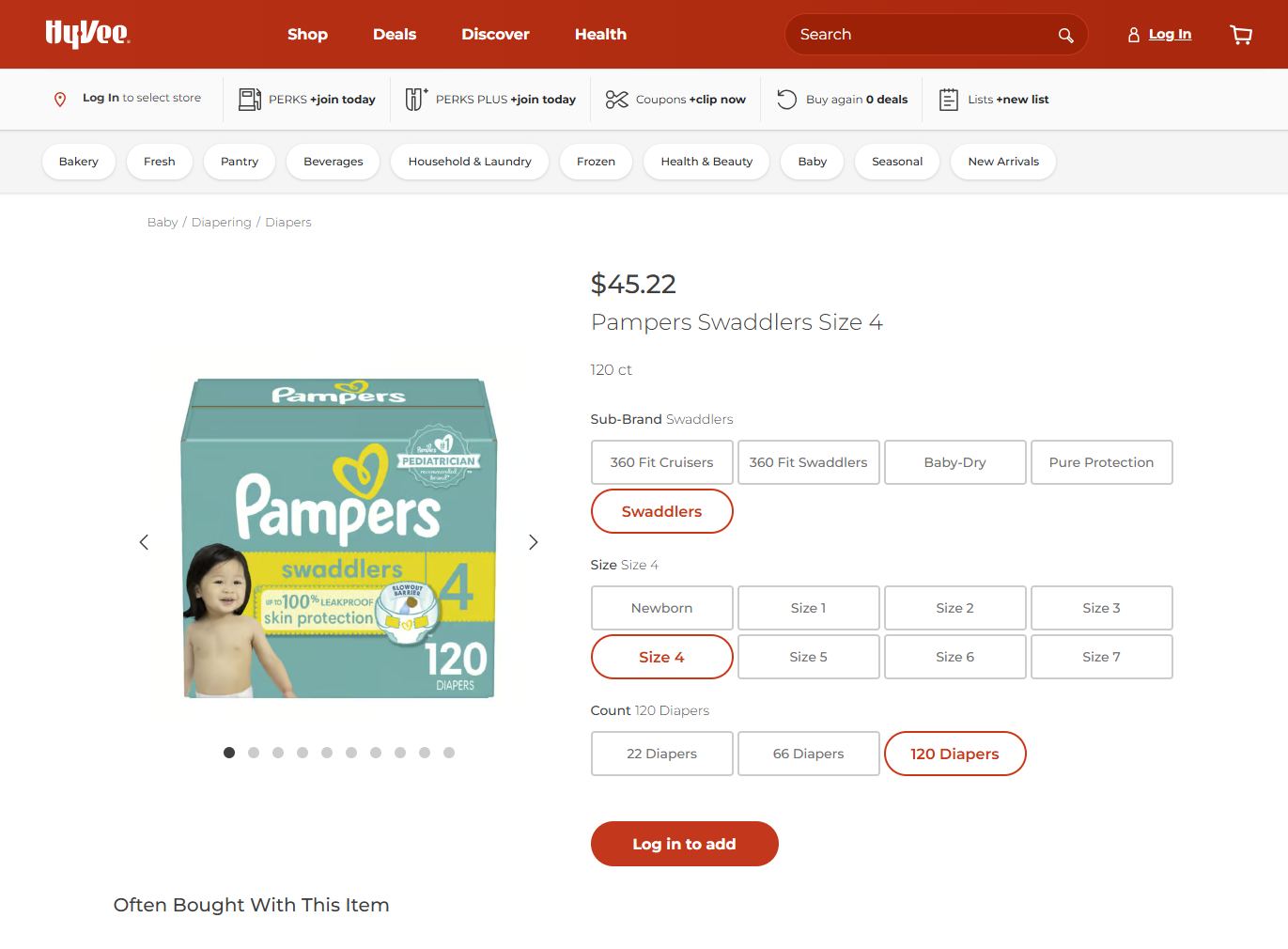
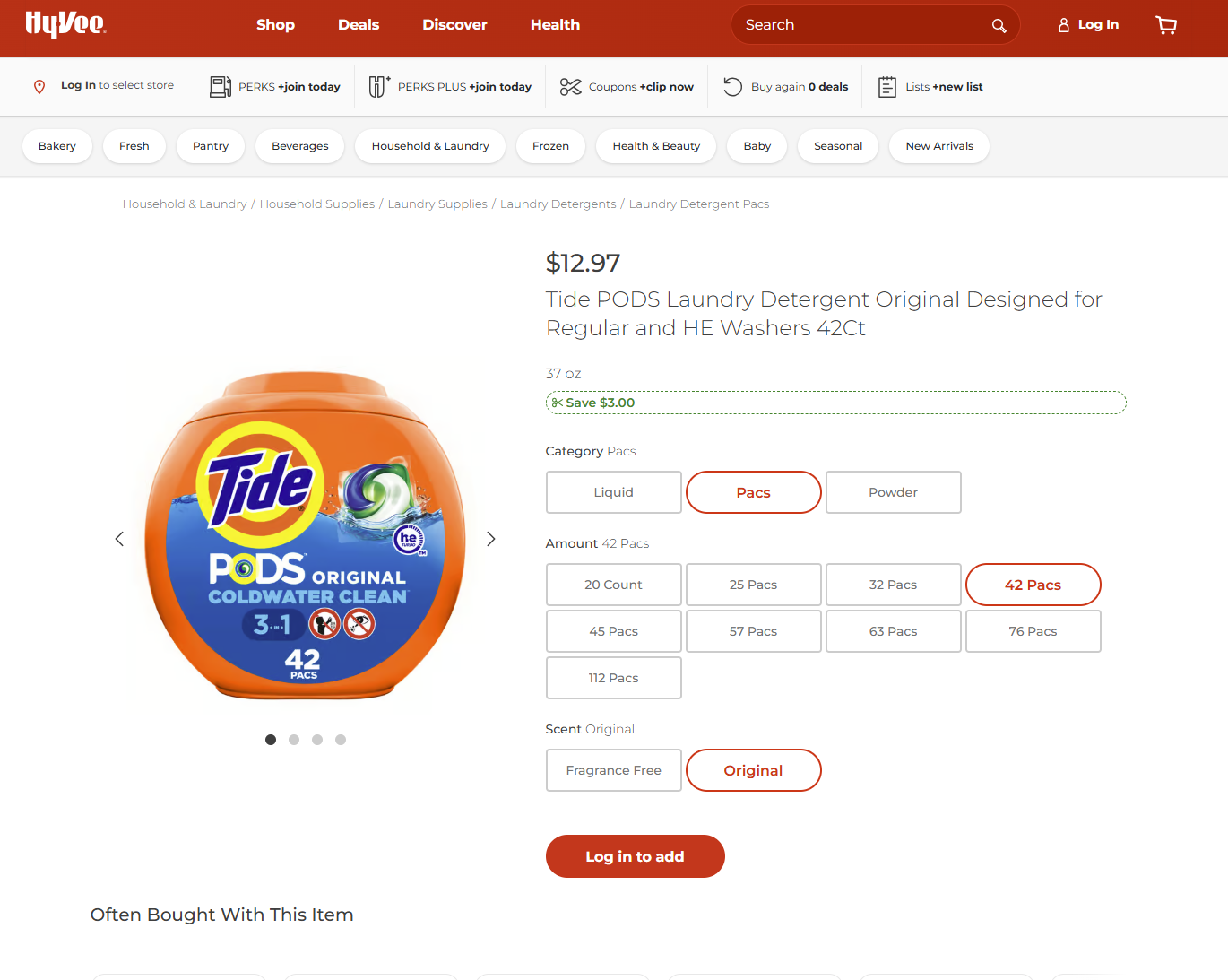
Recommendations API
Our first “super API,” Recommendations combines the output of multiple underlying engines—Predictions, Complements, Impulses, and Affinities—to deliver high-impact, highly personalized product suggestions.
This API supports real-time cart awareness, enabling dynamic cross-sells, basket expansion, and product discovery. Retailers can fine-tune the balance between behavioral signals and merchandising priorities, while customers enjoy smarter, context-aware recommendations across every aisle.
Powered by:
- Past Purchases: Shopper-specific data pulled from complete order history
- Affinities: Automatically discovered item relationships via association rule learning
- Complements: Manually curated pairings (e.g., peanut butter + bread, hot dogs + buns)
- Impulses: “Checkout aisle” logic built on a curated set of Categories that represent low-consideration, high-relevance items—like frozen novelties, candy, and grab-and-go snacks. Designed to surface impulse-buy products at just the right moment.
- Custom Specific groupings: e.g. Produce: A rotating set of personalized fresh produce suggestions
What it enables: Flexible merchandising logic: Retailers can fine-tune the recommendation mix by weighting any of the five APIs to match business goals or page placement
In a real-world A/B test against a leading AI-based recommendations engine:
- +63% increase in daily add-to-cart revenue
- Before: $2,029/day
- After Prodx API:$3,310/day
- +14% increase in add-to-cart conversion rate
- Gains were driven not just by more products added—but by higher-value products selected through attribute-level personalization
These results underscore the power of grounded, structured data. When you understand what a shopper values, your recommendations don’t just get clicked—they get results.
Why it’s different: Most recommendation engines are black boxes—or rely solely on co-purchase history. The Recommendations API is fully transparent, configurable, and built on top of a deeply structured data foundation.
Relevancy isn’t static—it’s dynamic, inferred from:
- The shopper’s real preferences (from product attributes, not just SKUs)
- The category context
- The flexibility to prioritize affinities, complements, purchases, produce or impulse logic depending on placement and intent
By giving retailers full control over the logic behind the recommendations—without having to write custom rules—the API enables smarter, more personalized, and more profitable digital shelves.
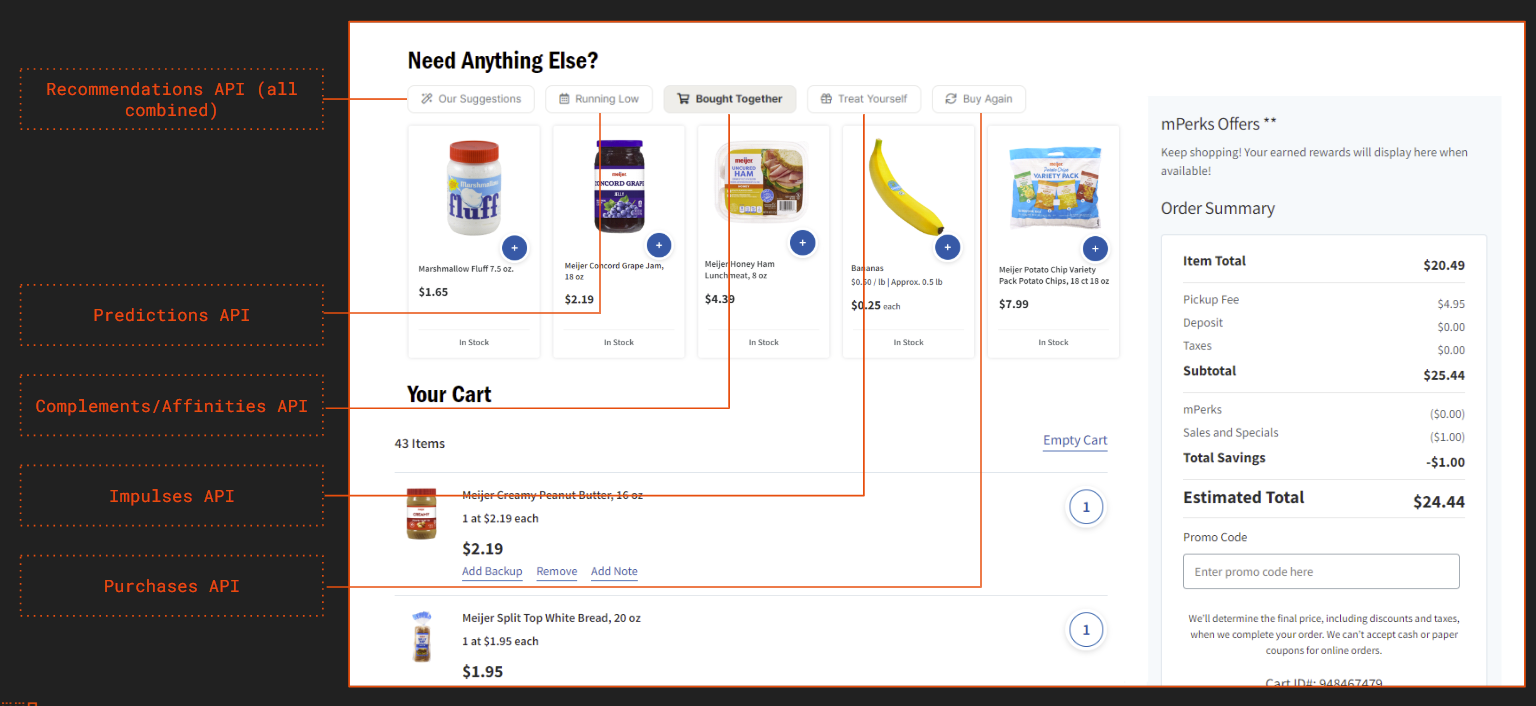
Search API
Delivers highly relevant, attribute-driven search results for shopper queries—ranked using product meaning, not just keywords. Built on Prodx’s deeply structured product data, this API understands the difference between a strawberry and a strawberry-flavored product, or between hamburger meat and ground beef.
Layered merchandising logic allows retailers to dynamically elevate private label, on-sale items, past purchases, sponsored products, or any other slot type—without disrupting relevance or shopper experience.
- Powered by: Attribute synonyms, Category hierarchy, Corrections, and Quality/Quantity structures
- What it enables: More accurate, forgiving, and highly relevant keyword search experiences—delivering results that reflect not just the query, but the intent behind it.
- Why it’s different: Unlike keyword-based search engines that rely on string matching or rule layering, the Prodx Search API understands the meaning behind the query—because it’s built on structured, standardized product data.
Each product in the catalog is deeply enriched with attributes, categories, and synonyms that define what it actually is, not just what words are on the label.
Because of this, our search engine can:
- Differentiate between, as we like to say what is “beef beef” (steak) and “beef” (beef hot dog, beef sausage)
- Prioritize “ground beef” for a query like “hamburger”
- Understand that “strawberry” means something different than “strawberry” the flavor
Search results are tiered based on “categoriness”—a concept built into our data model that scores how directly a product matches the intended meaning of the query. Results are grouped by levels of relevance, determined by:
- Category synonyms (e.g., “hamburger” as a synonym for Ground Beef)
- Attribute match strength
- Product type precision(e.g., whole fruit vs. fruit-flavored snacks)
Because this relevance logic is defined at the category and attribute level, not through brittle keyword rules, it scales across the entire catalog with consistency and accuracy.
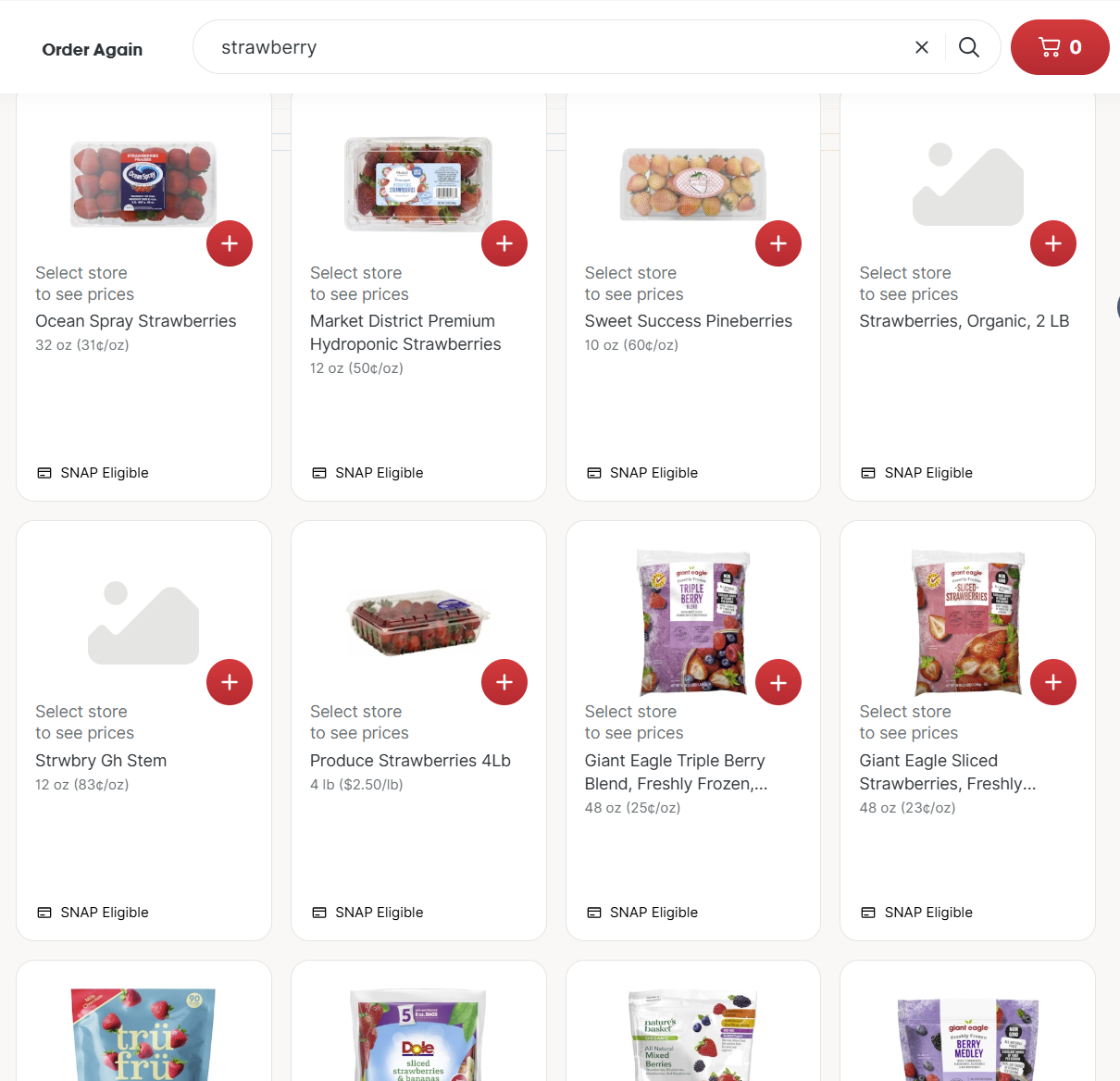
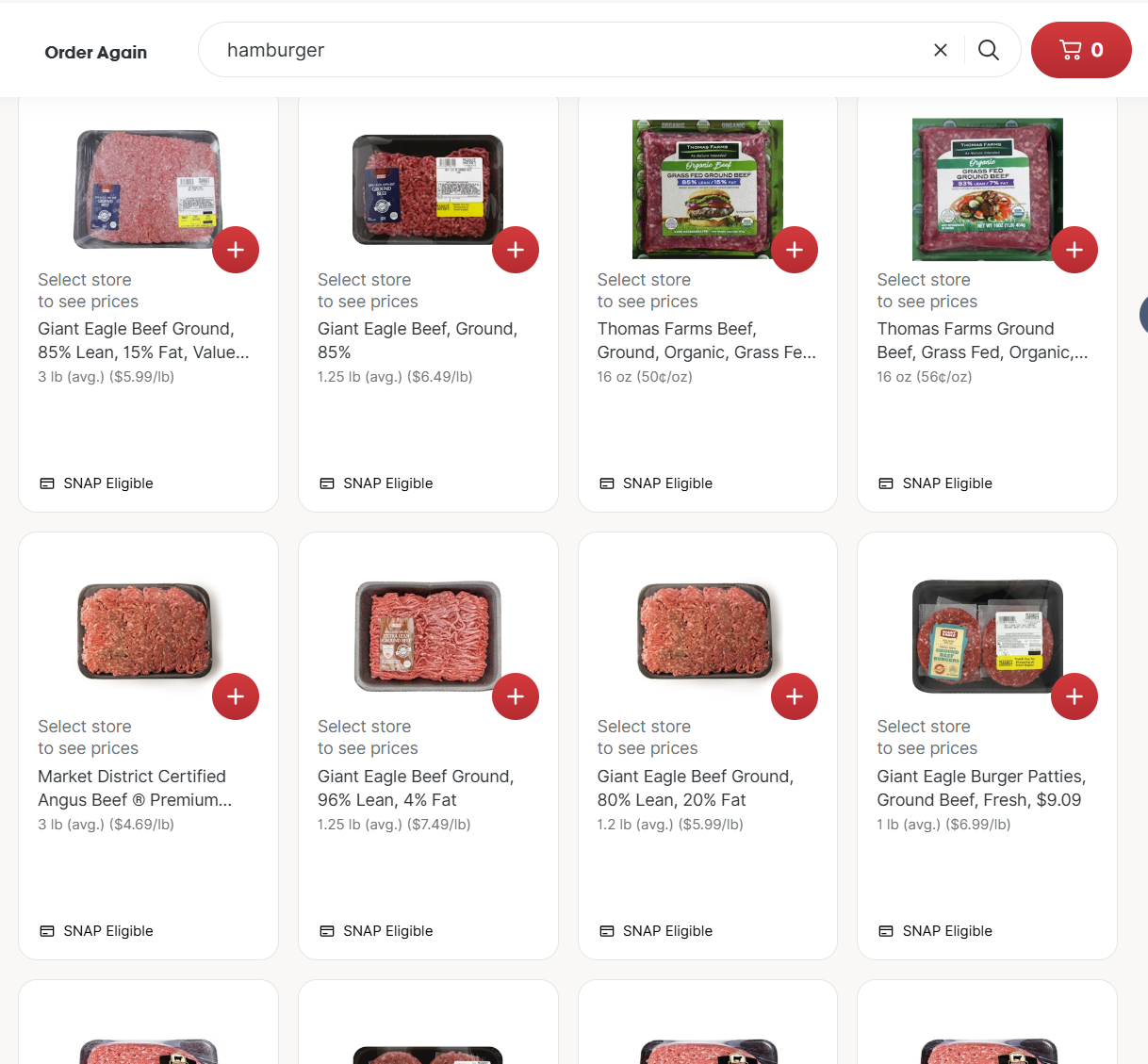
Substitutes API
Returns a list of relevant, personalized substitute products for any given item. The API factors in product attributes, shopper preferences, and quantity equivalence (e.g., recommending two half-gallon milks instead of one gallon) to surface truly viable alternatives.
Use cases include “Similar Items” carousels, substitution logic for out-of-stock items, and fulfillment integrations. Results can be dynamically merchandised to prioritize private label, past purchases, ads, or high-margin items, making every substitution both relevant and strategic.
- Powered by: Category-level similarity, Quantity standardization, and Attribute matching.
- What it enables: Intelligent product replacements that consider size, type, and shopper preference.
- Why it’s different: Unlike traditional substitution engines that rely on static tags or simple product associations, the Prodx Substitutes API is built from the ground up using category-specific logic embedded directly into the data model.
For every Category in our system, we define a set of relevant QualityTypes—the specific attributes that matter most when a shopper is choosing between products. We then assign a Substitution Rank (SuRank) to each QualityType, determining how heavily it should weigh into substitution decisions.
For example, in the Diapers category:
- Size is the most critical attribute for a viable substitute
- Followed by Brand, Sub-Brand, and even contextual dimensions like Time of Day (e.g., overnight vs. daytime)
This ranking structure is unique to each Category. In Coffee, for instance, we might prioritize Caffeine (Decaf vs. Not), then Single Serve, Coffee Type, and Roast Type.
Because this logic is defined at the data layer, not the application layer, every substitution is inherently aligned with how real shoppers compare and choose products. It also means the API is fully scalable and category-aware out of the box, without the need for custom rules per retailer or product group.
This approach delivers more accurate, relevant, and context-aware substitutions—which leads to higher conversion, better shopper satisfaction, and fewer bad replacements.
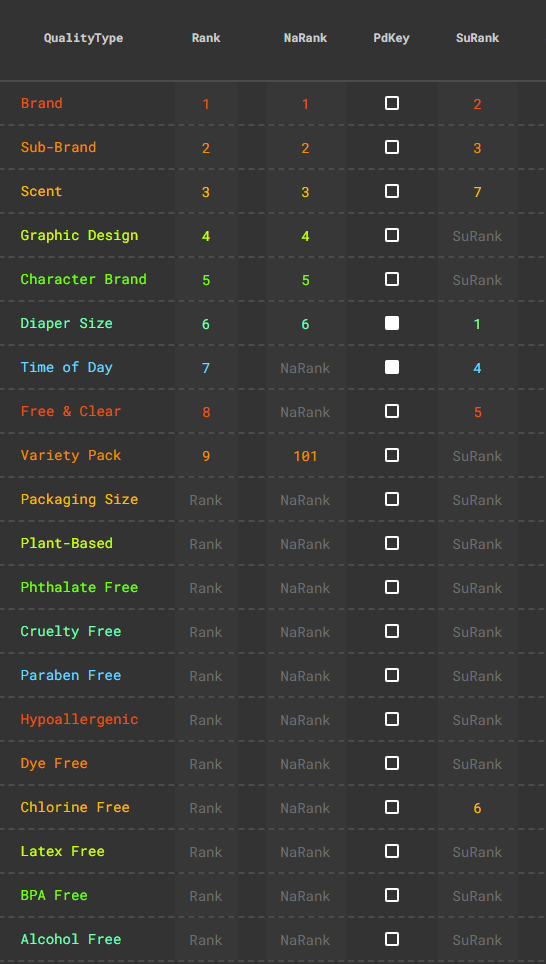
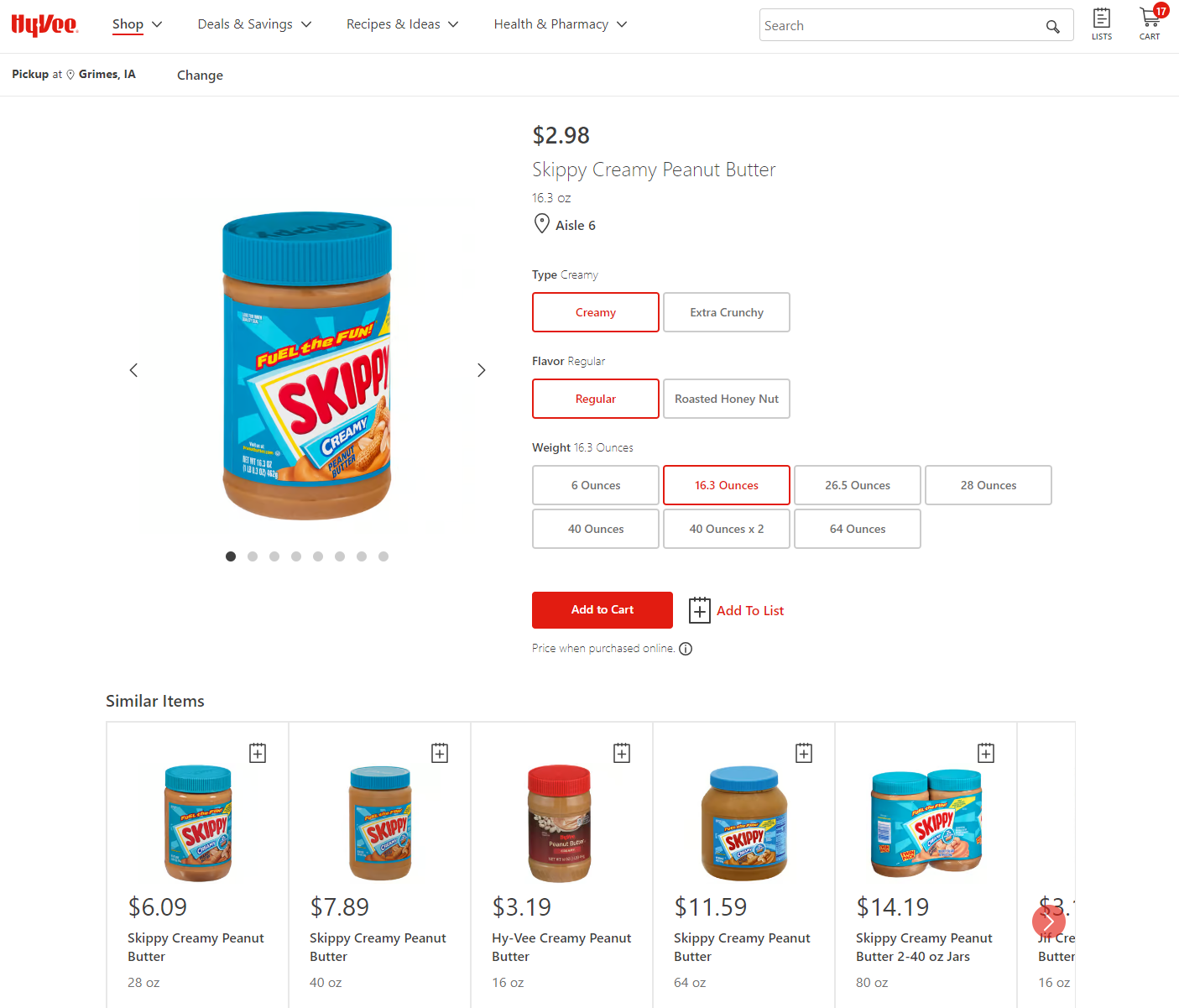
Ready to stop fixing product data and start using it?
Learn more

